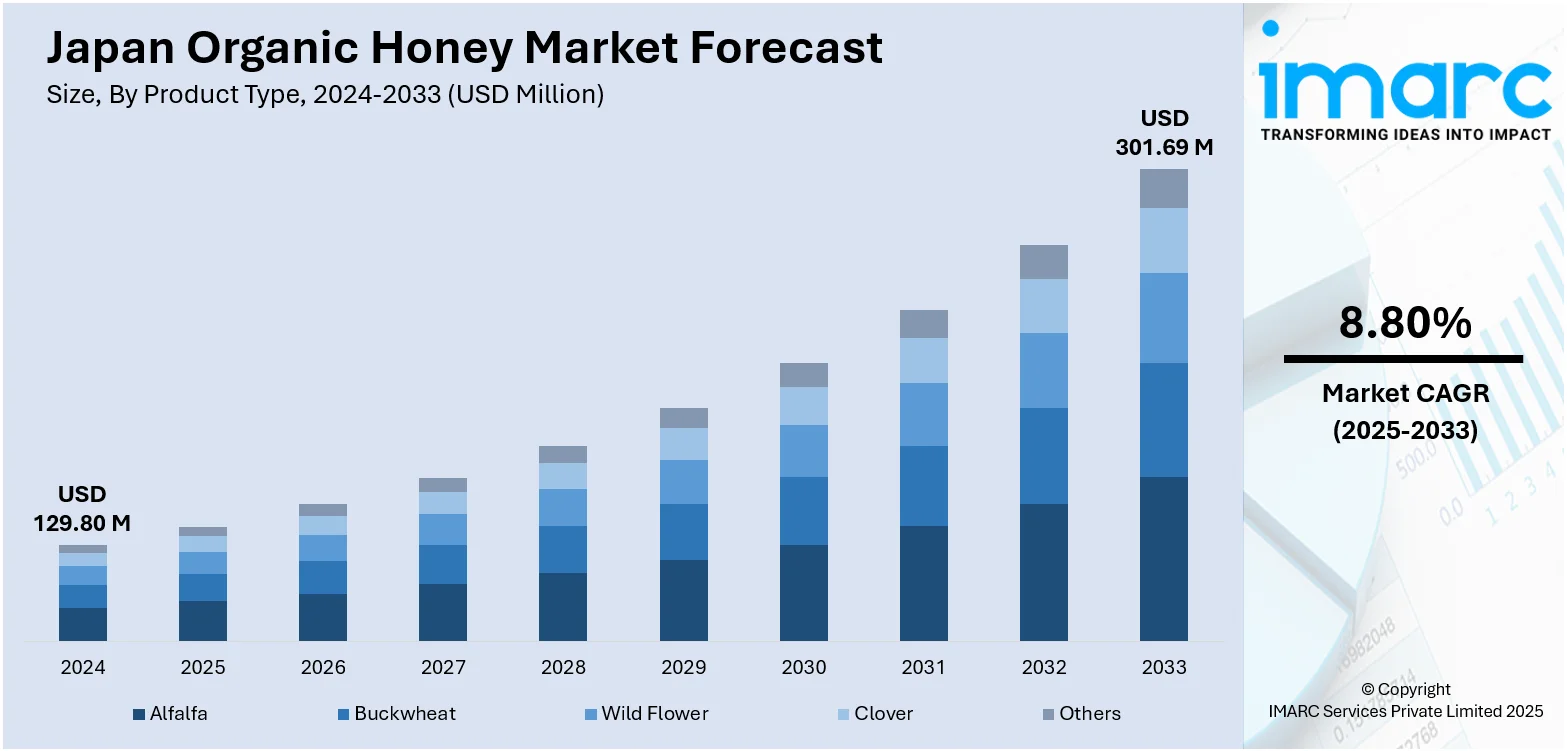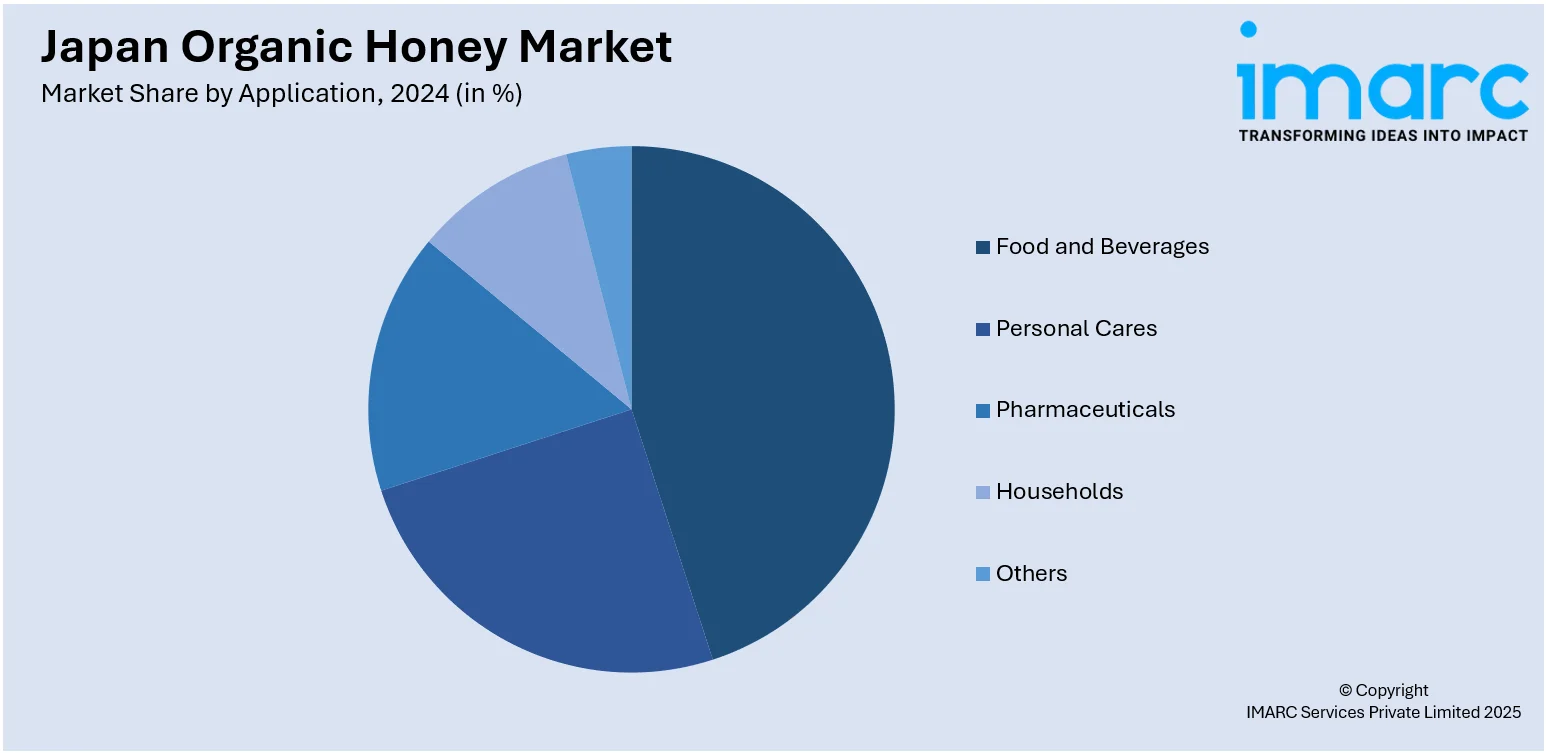
Japan Organic Honey Market Size, Share, Trends and Forecast by Product Type, Application, Packaging, and Region, 2025-2033
Japan Organic Honey Market Overview:
The Japan organic honey market size reached USD 129.80 Million in 2024. Looking forward, IMARC Group expects the market to reach USD 301.69 Million by 2033, exhibiting a growth rate (CAGR) of 8.80% during 2025-2033. At present, Japanese consumers are increasingly adopting healthy lifestyle habits, which are driving the demand for organic food products. Moreover, the rising need for natural sweeteners in food and beverages is contributing to the market growth. Apart from this, the growing usage of organic ingredients because of their healing, moisturizing, and antimicrobial properties in the personal care and beauty industry is expanding Japan organic honey market share.
|
Report Attribute
|
Key Statistics
|
|---|---|
|
Base Year
|
2024
|
|
Forecast Years
|
2025-2033
|
|
Historical Years
|
2019-2024
|
| Market Size in 2024 | USD 129.80 Million |
| Market Forecast in 2033 | USD 301.69 Million |
| Market Growth Rate 2025-2033 | 8.80% |
Japan Organic Honey Market Trends:
Rising Consumer Perception of Health and Wellness Gains
Japanese consumers are increasingly adopting healthy lifestyle habits, which are driving the demand for organic food products, such as honey. This is driven by increased awareness about lifestyle diseases, food safety, and the perceived quality of organic ingredients to ensure overall well-being. Organic honey is gaining recognition for its antibacterial, antioxidant, and anti-inflammatory properties to enhance immunity, digestive health, and skin care. This health-conscious shift in consumption is driven by the large-scale dissemination of information in digital media, wellness forums, and health influencers. To add to this, the Japanese government's focus on preventive medicine is further consolidating public demand for natural remedies. Consequently, organic honey is progressively taking over synthetic sweeteners and traditional honey in homes and high-end wellness products. To address this, retailers are reacting by increasing shelf space and variety of products across supermarkets, specialty stores, and internet channels, taking advantage of this informed and quality-driven consumer. In 2024, Tanzania’s Swahili Honey expanded its market presence by launching in Japan. The brand exported its first 20-ton shipment of organic honey to Japan.

To get more information on this market, Request Sample
Increasing Applications in Functional Foods and Beverages
Organic honey usage in food and beverages is growing at a fast pace as a natural sweetener and health-promoting additive across various product ranges. Organic honey is being actively used by Japanese companies in the production of health beverages, nutrition bars, yogurts, and herbal teas. The factor behind this is the transition toward clean-label ingredients and the growing consumer demand for food products with specific health-promoting characteristics in addition to fundamental nutrition. This dynamic world of product innovation is triggering demand both from the manufacturer and consumer sides for authenticity and effectiveness. Organic honey is also serving Japan's ageing population, as they are searching for products supporting immunity, brain health, and lower inflammation. The number of elderly people in Japan reached a record 36.25 million in 2024, with individuals aged 65 and above making up nearly one-third of the population, based on government statistics. This increment in geriatric population further heightened the requirement for organic honey in Japan.
Rising Demand for Natural and Ethical Beauty Products
The rising usage of organic ingredients because of their healing, moisturizing, and antimicrobial properties in the personal care and beauty industry is contributing to the Japan organic honey market growth. Organic honey is being used by skincare companies in making creams, lotions, lip balms, and shampoos, which they market as both natural and ethically produced. This trend is being driven by consumers' need for transparency, sustainability, and the lack of harmful chemicals in cosmetic products. Individuals, especially urban women with a consciousness of beauty, are inclined towards products containing multifunctional, natural ingredients that are both cosmetic and therapeutic. The popularity of organic honey as a mild, nourishing material is being boosted by increased Japanese beauty trends focusing on purity, simplicity, and nature-based solutions. Moreover, brands are taking advantage of this demand by emphasizing cruelty-free testing, green packaging, and organic certifications, which further add value to organic honey's value proposition in the beauty space. In 2025, Guerlain launched six new shades of its KissKiss Bee Glow Pearly lip balm variety in Japan. The product is infused with the goodness of Corsican honey and adapts to the lips’ natural color.
Japan Organic Honey Market Segmentation:
IMARC Group provides an analysis of the key trends in each segment of the market, along with forecasts at the country and regional levels for 2025-2033. Our report has categorized the market based on product type, application, and packaging.
Product Type Insights:
- Alfalfa
- Buckwheat
- Wild Flower
- Clover
- Others
The report has provided a detailed breakup and analysis of the market based on the product type. This includes alfalfa, buckwheat, wild flower, clover, and others.
Application Insights:

- Food and Beverages
- Personal Cares
- Pharmaceuticals
- Households
- Others
The report has provided a detailed breakup and analysis of the market based on the application. This includes food and beverages, personal cares, pharmaceuticals, households, and others.
Packaging Insights:
- Glass Jar
- Bottle
- Tub
- Others
A detailed breakup and analysis of the market based on the packaging have also been provided in the report. This includes glass jar, bottle, tub, and others.
Regional Insights:
- Kanto Region
- Kansai/Kinki Region
- Central/ Chubu Region
- Kyushu-Okinawa Region
- Tohoku Region
- Chugoku Region
- Hokkaido Region
- Shikoku Region
The report has also provided a comprehensive analysis of all the major regional markets, which include Kanto Region, Kansai/Kinki Region, Central/ Chubu Region, Kyushu-Okinawa Region, Tohoku Region, Chugoku Region, Hokkaido Region, and Shikoku Region.
Competitive Landscape:
The market research report has also provided a comprehensive analysis of the competitive landscape. Competitive analysis such as market structure, key player positioning, top winning strategies, competitive dashboard, and company evaluation quadrant has been covered in the report. Also, detailed profiles of all major companies have been provided.
Japan Organic Honey Market Report Coverage:
| Report Features | Details |
|---|---|
| Base Year of the Analysis | 2024 |
| Historical Period | 2019-2024 |
| Forecast Period | 2025-2033 |
| Units | Million USD |
| Scope of the Report |
Exploration of Historical Trends and Market Outlook, Industry Catalysts and Challenges, Segment-Wise Historical and Future Market Assessment:
|
| Product Types Covered | Alfalfa, Buckwheat, Wild Flower, Clover, Others |
| Applications Covered | Food and Beverages, Personal Cares, Pharmaceuticals, Households, Others |
| Packagings Covered | Glass Jar, Bottle, Tub, Others |
| Regions Covered | Kanto Region, Kansai/Kinki Region, Central/ Chubu Region, Kyushu-Okinawa Region, Tohoku Region, Chugoku Region, Hokkaido Region, Shikoku Region |
| Customization Scope | 10% Free Customization |
| Post-Sale Analyst Support | 10-12 Weeks |
| Delivery Format | PDF and Excel through Email (We can also provide the editable version of the report in PPT/Word format on special request) |
Key Questions Answered in This Report:
- How has the Japan organic honey market performed so far and how will it perform in the coming years?
- What is the breakup of the Japan organic honey market on the basis of product type?
- What is the breakup of the Japan organic honey market on the basis of application?
- What is the breakup of the Japan organic honey market on the basis of packaging?
- What is the breakup of the Japan organic honey market on the basis of region?
- What are the various stages in the value chain of the Japan organic honey market?
- What are the key driving factors and challenges in the Japan organic honey market?
- What is the structure of the Japan organic honey market and who are the key players?
- What is the degree of competition in the Japan organic honey market?
Key Benefits for Stakeholders:
- IMARC’s industry report offers a comprehensive quantitative analysis of various market segments, historical and current market trends, market forecasts, and dynamics of the Japan organic honey market from 2019-2033.
- The research report provides the latest information on the market drivers, challenges, and opportunities in the Japan organic honey market.
- Porter's five forces analysis assist stakeholders in assessing the impact of new entrants, competitive rivalry, supplier power, buyer power, and the threat of substitution. It helps stakeholders to analyze the level of competition within the Japan organic honey industry and its attractiveness.
- Competitive landscape allows stakeholders to understand their competitive environment and provides an insight into the current positions of key players in the market.
Need more help?
- Speak to our experienced analysts for insights on the current market scenarios.
- Include additional segments and countries to customize the report as per your requirement.
- Gain an unparalleled competitive advantage in your domain by understanding how to utilize the report and positively impacting your operations and revenue.
- For further assistance, please connect with our analysts.
 Request Customization
Request Customization
 Speak to an Analyst
Speak to an Analyst
 Request Brochure
Request Brochure
 Inquire Before Buying
Inquire Before Buying




.webp)




.webp)












